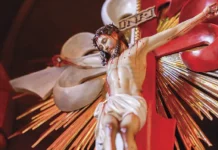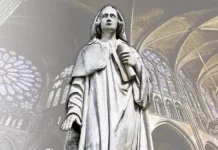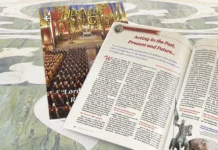This “civil war” in Paradise remains, to our eyes, an event shrouded by the clouds of mystery. To attempt to reconstitute it seems to be a theological utopia… But is that not precisely what makes the challenge so exciting?
The historian’s task seems at times to be a thankless one.
In this kind of study, it is common to run into incongruous sources, incomplete, damaged or even doubtful documents. It often becomes necessary to resort to estimation and conjecture, resources which, in common parlance, are called guessing…
Nevertheless, it must be admitted that the joy of finding the truth is proportional to the degree of difficulty involved in unravelling remote events, and the painstaking the mental effort that was required to unite and make sense of these vague elements. The more intricate the mystery, the more meritorious is the discovery.
Those who have taken up the challenge
One has the impression that something of this was experienced by the Fathers, Doctors and exegetes in setting out to reconstruct what happened at the inception of the angelic world. How to go about delineating facts that occurred even before the creation of man, and with beings of a nature different from ours? What documents to seek, what witnesses to call upon?
The only entirely credible source at their disposal was the Bible, which was extremely sparse in dealing with the subject.
To this could be added the stories contained in Old Testament apocrypha. These texts were certainly very beautiful and rich in impressive details, but they were overly fanciful, and the Church did not recognize them as canonical.
The Saints, each in his or her own turn, have come to admit that it is impossible to arrive at something conclusive in this regard, and much of what we have heard in our catechism classes about the sin of the Angels and the great battle that followed, the Prœlium Magnum, are mere hypotheses – solidly founded, to be sure, but which, however, are not unanimous and do not constitute matters of Faith.
Therefore, this “civil war” that occurred in Paradise remains, to our eyes, an event shrouded in mysterious clouds of uncertainty. To reconstitute it in a definitive way is properly a theological utopia… But is this not precisely what makes the challenge so exciting?
The battlefield
To delineate any historical fact, one of the first questions that arise is: where did it take place?
St. Thomas Aquinas1 holds that the Angels were created in a physical space. Since pure spirits rule the visible universe and possess dominion over matter, it was fitting that God created them in the most sublime corporeal location, to exercise this power from there.
The Angels’ centre of operations is, therefore, described as a wonderful region, free from corruption, full of light. Its name is Empyrean Heaven, that is, fiery Heaven, not owing to its heat, but rather its splendour.2
Number of combatants
A crucial factor in reconstructing the scene of a battle is the number of the warriors.
The Book of Daniel lists “thousands and thousands” and “tens of thousands” who stand before the throne of God (cf. Dn 7:10). This figure, which may seem like hyperbole to us, was seen differently by the Fathers of the Church. St Cyril of Jerusalem3 believes that the exaggeration was actually an understatement!
He considers that the parable of the Good Shepherd, who abandons ninety-nine sheep and goes in search of the one that was lost, alludes to the Word of God who, “leaving” the company of the Angels in Heaven, comes to earth to save mankind. Therefore, all of humanity, from Adam until the end of time, would be to the angelic world in a proportion of one to ninety-nine. And that would be counting only the faithful Angels!
A pre-human event

As far as the when is concerned, the Church has never pronounced on the exact moment when the heavenly militia appeared. The Fathers and Doctors have raised various suppositions, while taking notable care not to refute those who, after careful analysis, have tried to establish it.
St. Augustine,4 for example, sets the creation of the Angels in the first day of God’s work as narrated in Genesis, basing himself on the following verses of the sacred text: “And God said, ‘Let there be light’; and there was light. And God saw that the light was good; and God separated the light from the darkness” (Gn 1:3-4).
The holy Bishop of Hippo interprets the term “light” as a reference to the pure spirits. On the first day, God creates the Angels and sees that they are all good – it would be absurd to imagine that the demons were evil from the beginning, because God cannot be the cause of evil5 –; then He separates “light from darkness,” signifying sin and the expulsion of the demons.
From the very beginning, defined in terms of opposition
It is interesting to note that the narrative of the creation of light is followed immediately by its separation from darkness. This small detail has a very profound meaning, which can be understood from the words of St. John in his First Letter: “the devil has sinned from the beginning” (3:8).
From St. Thomas’ explanations6 on the subject, it appears that in the first instant of their existence, the Angels knew themselves to be mere creatures, distinct from the Almighty. This initial act was accompanied by a natural movement towards the good.
Now, we know that the angelic will is such that it does not bear the hesitations and regrets to which we men are accustomed. From the moment an Angel adheres to something, he will never retract the position he has taken.
If the evil angels had not immediately placed an obstacle in the way of their motion towards good, they would all have forever defined themselves in favour of God and would not have sinned. Accordingly, there cannot have been an interval between creation and the trial. The event which determined their eternal destiny must necessarily have taken place in the instant following the appearance of the Angels.
Thus it is fair to say that the first act of angelic free-will was to enlist in God’s squadron or in that of His enemies, and that opposition was bound up with their nature from the beginning.
Our next step is to discover what led them to such a decision.
The trial
Sacred Scripture and the Magisterium do not go into detail on the subject of the trial, thus leaving room for theological speculation.
According to Tertullian, St. Cyprian, St. Basil and St. Bernard, what decided the eternal destiny of the Angels was the proclamation of the Incarnation of the Word.7
St. Thomas,8 following the two main Patristic opinions, is much more generalized. For the Angelic Doctor, the angel first sinned by pride, wanting to be like God. Now, this would be granted to him if he persevered. For in this consists final beatitude: “we shall be like Him, for we shall see Him as He is” (1 Jn 3:2). However, the devil wanted to achieve this elevation, not by divine help, but by his own strength. The initial element of the test would be to acknowledge his dependence on the Creator in order to reach perfection.
Secondly, the bad angels were overshadowed by the eminent good granted by the Most High to a being of a nature inferior to their own: man. They became envious, not only of mankind, but also of God, who used this gift for His own glory.
What good was this? It could not be the gift of grace, by which we receive a participation of the divine nature. This, as has been seen, the devil knew that he also possessed. It must be something superior. All the evidence seems to converge on the Person of Our Lord Jesus Christ, but St. Thomas prefers not to draw such a conclusion…
However, the parsimony of the holy Doctor ultimately opens room for us to go beyond the figure of the Incarnate Word. It is evident that Our Lord is infinitely above all the angelic spirits. But are there not others especially beloved to whom He has conferred a dignity superior to the angelic? For example, why not suppose that Our Lady, Mother of God and Queen of Angels, was also one of the elements of the trial?
A star falls from the firmament
Whatever the revelation made to the Angels, one of them rises up against the divine design and drags a whole legion with him. It is Lucifer.
This one, who until now had been the greatest among all the Angels,9 abandons his dignity to become the prototype of those whose names have been erased from the Book of Life (cf. Rv 20:15).
It would seem that the Bible is loath to mention him. The passages that deal with his act of rebellion, if analysed in a literal sense, always refer to other persons and circumstances.
His name does not appear once in the sacred text. The custom of referring to him that way comes from a verse in Isaiah, in which the prophet invokes the king of Babylon: “How you are fallen from heaven, O Day Star, son of Dawn!” (14:12).10
The term “day star” alludes to the planet Venus, also called the morning star by the ancients because it appears in the firmament before the sun.
St. Jerome, in the Vulgate, translates the expression as Lucifer. Now, as some Fathers applied this passage to the fall of the leader of the demons, this name began to be used to designate him.11
Nevertheless, it is very beautiful that the same title morning star, attributed to the highest of the Angels, is now one of the thousands of precious stones that adorn the crown of the Blessed Virgin. By her humility, Our Lady has merited a far superior dignity: She is the true Morning Star, whose throne is set above all the heavenly militia.
As for Lucifer’s infamous exclamation – “I will not serve!” – the prophet Jeremiah puts it on the lips of the people of Israel (cf. Jer 2:20).
The cry of fidelity
A spirit resists in the face of the greatest of Angels. His name, Michael – Mîka’el in Hebrew – expresses a question: “Who is like God?” The phrase recalls both the defiant cry of a knight without blemish, and the mystical interrogation of one who profoundly discerns the grandeur of the Most High and acknowledges his own nothingness before Him.
The contempt that the Scriptures seem to foster for the head of the demons contrasts with the veneration for the figure of St. Michael evident in its pages.
Of all the Angels who appear in the Book of Revelation, he is the only one mentioned by name. In the Book of Daniel, St. Gabriel himself praises his grandeur, calling him “Great Prince” (12:1).12 He – and he alone – receives from the Bible the title of Archangel (cf. Jude 1:9), that is to say, a superior Angel, the first among the heavenly militia.13
Michael gathers under his command all the Angels who remain faithful, and the war begins.

The battle commences
It is extremely difficult – if not impossible – to deduce and even imagine what a battle between pure spirits would be like.
It is certain that the Angels are very powerful. We know that one of them was enough to kill 185,000 men-at-arms of Sennacherib’s army in a single night (cf. 2 Kgs 19:35). A war between “thousands upon thousands” of these beings far surpasses the destructive power of any human weaponry.
But how would they fight? Would there be tactics, skirmishes, advances and retreats, in short, all that is proper to human wars? There are no elements even to raise hypotheses in this regard… save one.
Fortunately, one man mystically saw the war and left his description consigned to history. On this basis, something of the mystery is revealed.
St. John the Evangelist tells us in the Book of Revelation: “Now war arose in Heaven, Michael and his Angels fighting against the Dragon” (12:7).
According to one interpretation, here is stated that the good Angles have taken the lead. The first to advance is Michael with his army. It is only in the next sentence that the Dragon is said to have engaged in combat.14
The fight begins with an absolute advantage for the good hosts. In the first place, the faithful Angels outnumber the demons (cf. Rv 12:4). Moreover, St. Michael’s squadron has already passed the trial, and now enjoys beatific vision.15 Lucifer and his followers struggle solely with the gifts of nature, while the others have supernatural perfection: they are divinized.
“The Dragon and his angels fought, but they were defeated” (12:7-8).
The Dragon’s retaliation is followed immediately by his ruin: “they were defeated.” A humiliating defeat, as the original Greek suggests: “they were not strong.”16 That is, Lucifer not only lost the war, but having rejected grace, he also lost the tremendous vigour of his angelic nature was reduced to a state of absolute weakness before the mighty hand of God.
Victory!
Once the triumph is established, St. Michael does not allow concessions or accords. His form of warfare, admitting no truce and no quarter, only stops when its ultimate consequences have been achieved. The just expulsion follows:
“And there was no longer any place for them in Heaven. And the great Dragon was thrown down, that ancient serpent, who is called the Devil and Satan, the deceiver of the whole world – he was thrown down to the earth, and his angels were thrown down with him” (12:8-9).
St. John seems to want to underscore the violence with which the demons were cast into the abyss. “There was no longer any place” is a Hebrew phrase indicating an expulsion with no turning back, a total and irreversible downgrading of a certain rank or dignity.17 As if this were not enough, the Apostle repeats twice “was thrown down”, almost as one who revels in the victory and wants to recall, savour and delight once again in the wonderful scene of the ultimate blow.
There are still many mysteries surrounding the event that inaugurated the history of the Angels. The loving research carried out over the centuries by Saints and Doctors has done little more than lift the corners of the veil.
Nevertheless, amid the many unknowns surrounding the Angels’ war of extermination against the demons, one truth remains abundantly clear: victory is the exclusive patrimony of those who fight for God. ◊
Notes
1 Cf. ST. THOMAS AQUINAS. Summa Theologiæ. I, q.61, a.4.
2 Cf. Idem, q.66, a.3. By its properties, fire is the material element that best symbolises the angelic nature (cf. PSEUDO-DIONYSIUS AREOPAGITE. La jerarquía celeste, c.XV, n.2. In: Obras Completas. Madrid: BAC, 2007, p.156-158).
3 Cf. ST. CYRIL OF JERUSALEM. Catequeses pré-batismais. Petrópolis: Vozes, 1978, p.213.
4 Cf. ST. AUGUSTINE. De civitate Dei. L.XI, c.19-20. In: Obras. Madrid: BAC, 1958, t.XVI, p.746-748.
5 Cf. DH 286.
6 Cf. ST. THOMAS AQUINAS, op. cit., q.63, a.3; 6.
7 Cf. BERNET, Anne. Enquête sur les Anges. Paris: Perrin, 1997, p.41, nota 2.
8 Cf. ST. THOMAS AQUINAS, op. cit., q.63, a.2-3.
9 Cf. Idem, q.63, a.7.
10 The complete text is: “How you are fallen from Heaven, O Day Star, son of Dawn! How you are cut down to the ground, you who laid the nations low! You said in your heart, ‘I will ascend to Heaven; above the stars of God I will set my throne on high; I will sit on the mount of assembly in the far north; I will ascend above the heights of the clouds, I will make myself like the Most High.’ But you are brought down to Sheol, to the depths of the pit” (Is 14: 12-15).
11 Cf. GARCÍA CORDERO, OP, Maximiliano. Biblia comentada. Libros proféticos. Madrid: BAC, 1961, v.III, p.155.
12 According to the Jerusalem Bible translation.
13 Cf. BERNET, op. cit., p.127.
14 Cf. BARTINA, SJ, Sebastián. Apocalipsis de San Juan. In: NICOLAU, SJ, Miguel et al. La Sagrada Escritura. Nuevo Testamento. Madrid: BAC, 1962, v.III, p.706.
15 Cf. ST. THOMAS AQUINAS, op. cit., q.62, a.5.
16 Cf. BARTINA, op. cit., p.706.
17 Cf. Idem, p.707.







